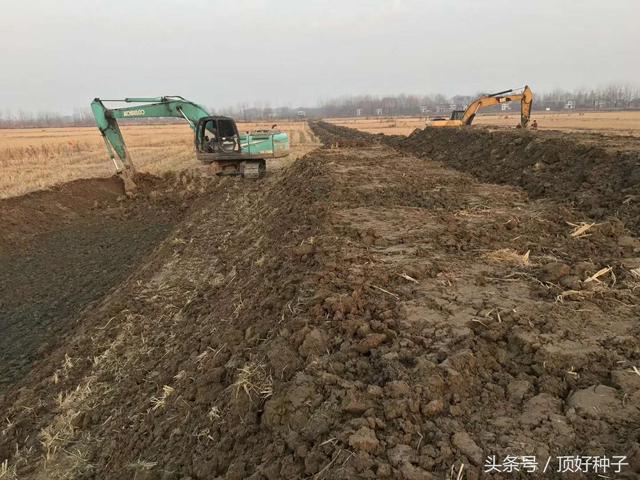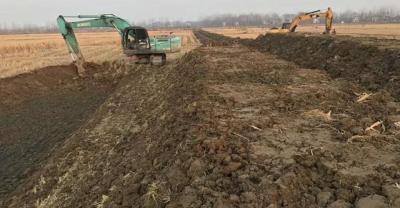Key techniques for high yield of crayfish in rice field
First, desilting and disinfection in winter and spring
Because of the characteristics of crayfish's living habits, crayfish generally prefer the water environment with good water quality and rich dissolved oxygen, and in the water environment, it is necessary to maintain less silt. If there is a large amount of silt, it will not only cause crayfish hypoxia, but also cause crayfish not to eat because of too much organic matter, affecting the survival of crayfish. In addition, the poor water environment will also cause more harmful gases such as biogas in the living environment, which will seriously lead to crayfish poisoning. If there are a lot of germs in the mud, it is not conducive to the health of crayfish. Therefore, in order to ensure the normal survival and proliferation of crayfish, the water environment of crayfish needs to be cleaned regularly, especially in winter and spring, the paddy fields need to be desilted and dried to reduce the bacteria in the water, and quicklime is also needed to disinfect the crayfish to reduce the probability of crayfish diseases.
II. Rebuilding and strengthening the ridges of paddy fields
Crayfish generally live in caves in winter and summer, so the quality of rice ridges must be ensured in the process of infrastructure construction of rice field culture. The most basic construction of rice ridges should be solid, not to be greatly affected by the external environment, and to prevent them from being washed away by heavy rain. Generally, the ridge should be about 1 m high and 0.8 m wide. In addition, the base of the ridge should be widened to about 1.5 m. The upper and both sides of the ridge must be completely tamped to keep the overall surface flat.
In addition, pay attention to the annual rice cultivation, we need to ensure that some shrimp that have not been fully fished will not be damaged.

Rice field transformation
III. Quantitative, timing, qualitative and fixed-point feeding
Because crayfish have the habit of gluttony and competition for food, and they also like to come out at night to find food, they can be fed in the shallow water by the pool and fed once a day in the morning and evening. The amount of feeding in the morning is less, accounting for only 30% ~ 40% of the total daily feed, while the amount of feeding in the evening is more, accounting for 60 ~ 70% of the total daily feed. It is worth noting that crayfish do not have a good swimming ability, often can only be in a small range of activities, be sure to achieve quantitative feeding, regular feeding, qualitative feeding, fixed-point feeding.
Pay attention to water quality
Be sure to pay attention to the cleanliness of the water quality in the pond, make sure that the water in the pond is brown or mung bean color, and the pond water change frequency is controlled at 15 ~ 20 days per time. If it is a hot summer, then the pond water change frequency can be faster, controlled at 5 ~ 7 days per time, and the dissolved oxygen content of the pond water quality is higher than 4 mg/L,PH. The dissolved oxygen value should be controlled at 7 ~ 9, and 20% ~ 30% of the water in the pond should be replaced each time.
5. Regular water quality disinfection
Regularly sprinkle disinfectant or quicklime in the whole pond, and in the middle and later stages of crayfish culture, 40 ~ 60 g/m3 sediment improver + 5 ~ 6 g/m3 photosynthetic bacteria were used to disinfect the pond every month.

crawfish
- Prev

Raising bamboo rats earns 200000 yuan a year
Bamboo rat breeding in recent years, Liucheng County has made great efforts to develop bamboo rat breeding project, and now it has begun to take shape. What does the breeding industry make money? 1800 farmers in the county raise bamboo rats 4.
- Next

Matters needing attention in emu culture
Matters needing attention in emu culture
Related
- On the eggshell is a badge full of pride. British Poultry Egg Market and Consumer observation
- British study: 72% of Britons are willing to buy native eggs raised by insects
- Guidelines for friendly egg production revised the increase of space in chicken sheds can not be forced to change feathers and lay eggs.
- Risk of delay in customs clearance Australia suspends lobster exports to China
- Pig semen-the Vector of virus Transmission (4)
- Pig semen-the Vector of virus Transmission (3)
- Five common causes of difficult control of classical swine fever in clinic and their countermeasures
- Foot-and-mouth disease is the most effective way to prevent it!
- PED is the number one killer of piglets and has to be guarded against in autumn and winter.
- What is "yellow fat pig"? Have you ever heard the pig collector talk about "yellow fat pig"?

